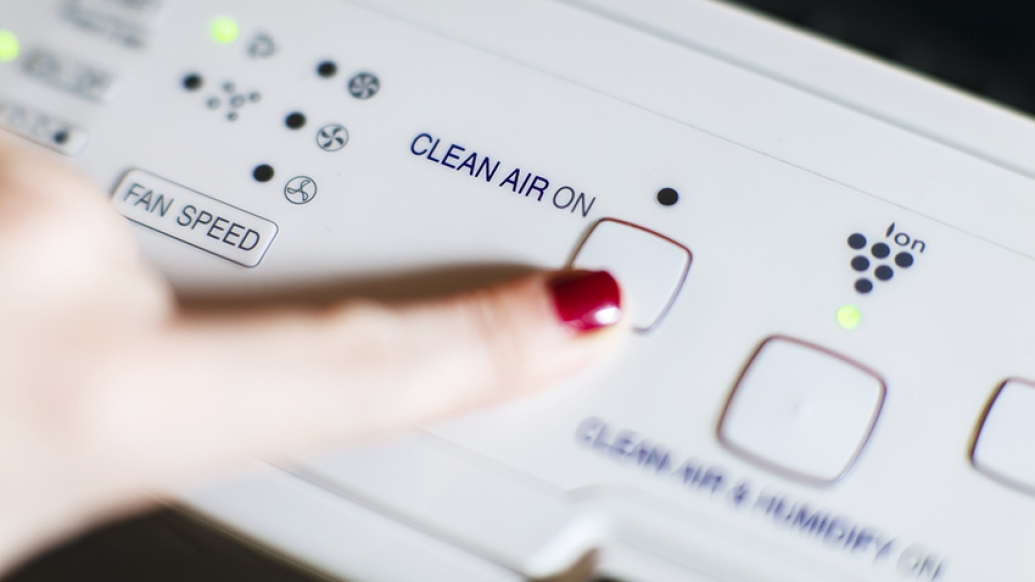The fifth-leading risk factor for mortality worldwide, air pollution presents a major heart health risk. A simple intervention could help people breathe easier at home.
1:00 PM
Author |

Microscopic particles floating in the air we breathe come from sources such as fossil fuel combustion, fires, cigarettes and vehicles. Known as fine particulate matter, this form of air pollution increases the risk of cardiovascular and other serious health problems.
LISTEN UP: Add the new Michigan Medicine News Break to your Alexa-enabled device, or subscribe to our daily audio updates on iTunes, Google Play and Stitcher.
"Despite improvements in air quality across the U.S. during the past few decades, more than 88,000 deaths per year occur in the U.S. due to fine particulate matter air pollution exposure," says Robert Brook, M.D., a cardiovascular medicine specialist at the University of Michigan's Frankel Cardiovascular Center.
Now, researchers have found that an inexpensive portable air purifier used inside a home is powerful enough to round up a good portion of those miniscule particles and get them out of the indoor air — a simple move that may protect the heart.
A recent study published in JAMA Internal Medicine found three days of using a low-cost air purifier at home significantly lowered urban seniors' fine particulate matter exposure. It also significantly lowered their blood pressure, which is the leading cause of morbidity and mortality worldwide.
"The results show that a simple practical intervention using inexpensive indoor air filtration units can help protect at-risk individuals from the adverse health effects of fine particulate matter air pollution," says Brook, the study's senior author.
He conducted the research with colleagues from the University of Michigan and Michigan State University, including first author Masako Morishita, Ph.D., of MSU.
Improving indoor air
Because the nation's population spends nearly 90 percent of its time indoors, researchers focused on exposure to pollutants while people are inside their own homes.
So instead of heading to a highway or factory, or even a park, Brook and his colleagues took their air pollution fight to living rooms and bedrooms in low-income senior housing in Detroit.
MORE FROM THE LAB: Subscribe to our weekly newsletter
Forty seniors participated in this randomized, double-blind study between fall 2014 and fall 2016. Ninety-five percent of the participants were black; all were nonsmokers.
Each person experienced three different three-day scenarios: a sham air filter (an air filtration system without a filter), a low-efficiency air purifier system and a high-efficiency air purifier system.
Participants went about their normal business during the study period and were allowed to open windows and go outside as often as they wished. Blood pressure was measured each day, and participants wore personal air monitors to determine their personal air pollution exposure.
[A] simple practical intervention using inexpensive indoor air filtration units can help protect at-risk individuals from the adverse health effects of fine particulate matter air pollution.Robert Brook, M.D.
The researchers focused on reduced air pollutant exposure and lowered blood pressure over a three-day period as an indication of the portable air filters' potential to be cardioprotective.
As a result, Brook says fine particulate matter exposure was reduced by 40 percent, and systolic blood pressure was reduced by an average of 3.4 mm Hg (normal systolic blood pressure is considered less than 120 mm Hg; stage 1 hypertension begins at 130 and stage 2 at 140).
"The benefits were even more marked in obese individuals who had 6 to 10 mm Hg reduction in systolic blood pressure," says Brook, also a professor of internal medicine at the U-M Medical School.
And even a small investment could reap big benefits: High-efficiency air purifiers reduced pollutant exposure to a greater degree, but they didn't lower people's blood pressure more significantly than low-efficiency air purifiers, which are widely available for less than $70 apiece.
A relatable model
Existing research has investigated air pollution's cardiovascular and metabolomic effects in heavily polluted areas, also reporting some improvements after deploying air filters.
However, Brook says his team's report adds an important new consideration: It was conducted in a much cleaner environment that already met existing air quality standards for fine particulate matter yet still showed the potential to reduce exposure.
SEE ALSO: How Environmental Pollutants and Genetics Work Together in Rheumatoid Arthritis
"During the time of the study in Detroit, outdoor fine particulate matter levels averaged 9 micrograms per cubic meter, which is within the National Ambient Air Quality Standards," Brook adds. "This strongly supports that even further improvements in air quality can be yet more protective to public health."
The JAMA Internal Medicine paper further differs from previous studies through its focus on an elderly and low-income population.
Researchers, Brook says, wanted to explore preventive strategies in everyday situations where aging adults are already dealing with other health conditions and may be on medications.
Nearly half of participants in the small study met the criteria for obesity — and their mean blood pressure would be classified as hypertensive, according to the 2017 American Heart Association/American College of Cardiology guideline.
It's also the first known pollution and heart health study to focus on a three-part combination of low-income seniors, an urban environment in the U.S. and personal exposures to fine particulate matter.
Clearing the air
Despite the findings in the small study, more research is needed.
"It's premature to recommend that our patients purchase indoor air filters to prevent heart diseases," Brook says.
His team plans to test the approach in more diverse populations to learn whether personal reductions in fine particulate matter exposure will lead to fewer heart attacks and other negative outcomes associated with high blood pressure.
Brook says future research must also study long-term effects of the intervention to see if the reduced blood pressure will stay lower over longer time periods and result in fewer cardiovascular events.
Currently available epidemiologic calculations predict an approximate 16 percent decrease in cardiovascular events if a 3.2 mm Hg reduction in systolic blood pressure is maintained for a period of months to years, the study's authors note.
"In the meantime, clinicians and medical societies should play an active role in supporting clean air regulations in the effort to improve the health of their patients and families," Brook says.

Explore a variety of healthcare news & stories by visiting the Health Lab home page for more articles.

Department of Communication at Michigan Medicine
Want top health & research news weekly? Sign up for Health Lab’s newsletters today!





